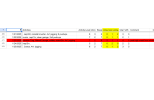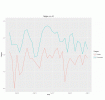@poetinsf, it is interesting to read of your approach to predicting PEM. I am currently struggling to hold enough information to be sure I understand what you say, welcome finding out more. (Sorry, what follows has become something of a ramble.)
When I spent a year recording all my activity in fifteen minute blocks, it helped me understand some of my patterns and highlighted some of the things I needed to consider when predicting PEM. It also helped me focus on looking for reasons why previous activity failed for me as a predictor. The big thing to come out of this for me was identifying some of my food intolerances. This was some twenty years ago when wearable devices were less common, and certainly now being more severely impaired I would not have the capacity to devote the amount of energy/time to doing something like this without it interfering with self care activities.
Also when I undertook this I was not aware of orthostatic issues, which now helps me in my informal subjective guesstimates for predicting future PEM. And I still have some unexpected fluctuation that does not seem to related to previous activity, diet or time spent upright, though for me novelty of an activity and concurrent sensory load seem also relevant. So your attempt to quantify effort is particularly interesting.
Your process of producing a combined score gives a figure that makes testing predictions more practical, but does it also make it harder for an individual to tease out individual components which needs to happen if they are to change behaviour to minimise triggering PEM. From my previous experience I would want it to be possible to break down any combined score into contributing components. If I was following on from my previous approach I would want to separate out previous activity, diet, sensory load, time upright and cognitive demands. So that you have the simple visual of a spike in one being followed predictably but a trough in activity being indicative of some form of causation.
We need a good observational study of activity patterns in people with ME/CFS that could then serve as a baseline for looking at what then results in triggering PEM or in eliminating as much as possible triggering overall reduction in activity levels. Producing predictive models, then means we can test the hypotheses it is based on.
Having a relapsing and remitting form of ME/CFS I experience periods of increasing activity levels and reducing activity levels that subjectively seem out of my control. All my relapses, even when associated with a new viral infection, were preceded by increases in activity, but I can not unambiguously conclude a causal relationships as I can not rule out some underlying fluctuation in a biological disease process unrelated to my activity levels, given by definition any relapse is preceded by a remission which inherently involves increased activity.
If we discover the underlying biological processes and have a treatment this becomes redundant, but until then being able quantify the relationship between activity levels/types and the future course of your condition, enables us to be clearer in advising on rest, pacing, etc. which in turn means new patients don’t have to spend the years or in my case decades learning how to manage their activity to minimise PEM and/or deterioration.
For most people ongoing activity monitoring would be an unhelpfully burden, but withe the right model and appropriate wearable devices, intermittent auditing for a week or a fortnight might be practical.


